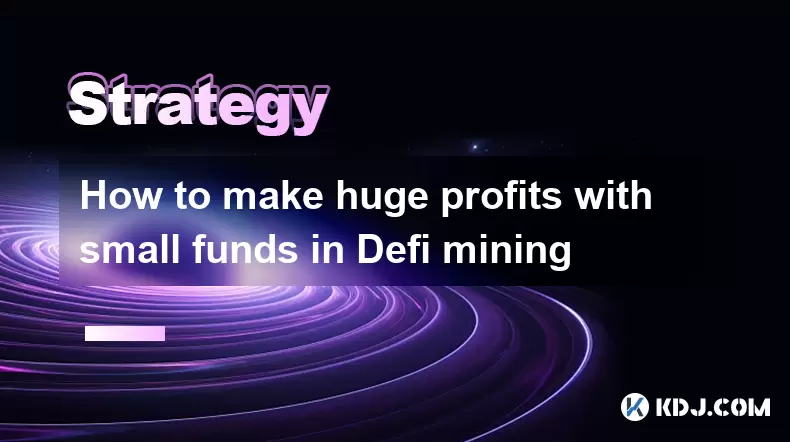-
 bitcoin
bitcoin $122288.232522 USD
0.16% -
 ethereum
ethereum $4480.662914 USD
-0.22% -
 xrp
xrp $2.962747 USD
-2.32% -
 tether
tether $1.000120 USD
-0.05% -
 bnb
bnb $1145.654223 USD
-2.07% -
 solana
solana $227.105217 USD
-1.67% -
 usd-coin
usd-coin $0.999548 USD
-0.02% -
 dogecoin
dogecoin $0.250875 USD
-2.04% -
 tron
tron $0.340654 USD
-0.49% -
 cardano
cardano $0.837968 USD
-2.52% -
 hyperliquid
hyperliquid $48.960449 USD
0.06% -
 chainlink
chainlink $22.049280 USD
-1.33% -
 ethena-usde
ethena-usde $1.000404 USD
0.02% -
 sui
sui $3.586212 USD
0.20% -
 avalanche
avalanche $29.894916 USD
-4.18%
How to make huge profits with small funds in Defi mining
DeFi mining allows huge profits with small funds through yield farming, staking, and lending on platforms like Compound, Aave, and Uniswap.
May 28, 2025 at 04:42 am

Introduction to DeFi Mining
DeFi, or Decentralized Finance, has revolutionized the way people interact with financial services, offering a platform where individuals can lend, borrow, and earn interest on their cryptocurrencies without the need for traditional financial intermediaries. One of the most attractive aspects of DeFi is mining, which allows users to earn significant returns on their investments. This article will explore how you can achieve huge profits with small funds through DeFi mining.
Understanding DeFi Mining
Before diving into the strategies, it's essential to understand what DeFi mining entails. DeFi mining refers to the process of participating in DeFi protocols to earn rewards. These rewards can come in the form of interest from lending, liquidity provision, or staking tokens. The key to making huge profits with small funds lies in selecting the right protocols and strategies that maximize your returns while minimizing risks.
Choosing the Right DeFi Protocols
Selecting the right DeFi protocols is crucial for maximizing your returns. Research is vital; you should look for protocols with a strong track record, high total value locked (TVL), and transparent governance. Some popular DeFi protocols include Compound, Aave, and Uniswap. Each of these platforms offers different opportunities for mining, and understanding their unique features can help you make informed decisions.
Strategies for Small Funds
When working with small funds, it's essential to adopt strategies that can amplify your returns. Here are some effective approaches:
Yield Farming: This involves providing liquidity to decentralized exchanges (DEXs) like Uniswap or SushiSwap. By doing so, you can earn a portion of the trading fees as well as additional tokens as rewards. Start small and diversify your investments across different pools to spread the risk.
Staking: Many DeFi projects offer staking rewards for holding their tokens. Platforms like Tezos and Cosmos allow you to stake your tokens and earn a steady income. This is a more passive approach compared to yield farming and can be suitable for those who prefer less active management.
Lending: Platforms like Aave and Compound allow you to lend your cryptocurrencies and earn interest. Choose assets with high demand to ensure you get the best rates. This strategy can be particularly effective if you're willing to lock in your funds for longer periods.
Risk Management in DeFi Mining
While DeFi mining can offer high returns, it also comes with significant risks. Volatility is a major concern, as the value of your assets can fluctuate rapidly. To manage this risk, consider the following:
Diversification: Spread your investments across different protocols and assets to reduce the impact of a single asset's downturn.
Regular Monitoring: Keep an eye on your investments and be ready to adjust your strategies based on market conditions. Use tools like DeFi Pulse and CoinGecko to stay updated on the latest trends and performance metrics.
Using Stablecoins: Investing in stablecoins like DAI or USDT can help mitigate the risk of volatility. These assets are pegged to the value of the US dollar, offering more stability compared to other cryptocurrencies.
Practical Steps to Start DeFi Mining
To start your journey in DeFi mining, follow these practical steps:
Set Up a Wallet: You'll need a secure wallet to store your cryptocurrencies. Popular options include MetaMask and Trust Wallet. Download the wallet, set it up, and secure it with a strong password and backup phrase.
Fund Your Wallet: Transfer your cryptocurrencies to your wallet. Ensure you have enough funds to start participating in DeFi protocols.
Connect to DeFi Platforms: Navigate to the website of the DeFi platform you wish to use. Connect your wallet to the platform by following the on-screen instructions.
Choose Your Strategy: Decide whether you want to engage in yield farming, staking, or lending. Each platform will have different options and interfaces, so take the time to understand how to participate.
Monitor and Adjust: Regularly check your investments and be prepared to adjust your strategy based on performance and market conditions.
Maximizing Returns with Small Investments
To maximize your returns with small investments, consider the following tips:
Reinvest Your Earnings: Reinvesting your earnings can compound your returns over time. Instead of withdrawing your profits, use them to increase your stake in the DeFi protocol.
Participate in New Projects: New DeFi projects often offer higher rewards to attract early adopters. However, be cautious and conduct thorough research to ensure the project is legitimate and has a strong foundation.
Use DeFi Aggregators: Platforms like Yearn.Finance and Zapper can help you optimize your DeFi investments by automatically moving your funds to the most profitable opportunities. These tools can be particularly useful for those with smaller funds.
Frequently Asked Questions
Q1: Can I start DeFi mining with just $100?A1: Yes, it is possible to start DeFi mining with as little as $100. Many DeFi platforms allow you to participate with small amounts, and strategies like yield farming and staking can be effective even with limited funds. However, be aware that smaller investments may carry higher relative risks due to potential fees and volatility.
Q2: How do I know if a DeFi project is safe to invest in?A2: To determine the safety of a DeFi project, look for factors such as the project's audit history, the transparency of its smart contracts, the team's background, and the project's community support. Platforms like DefiLlama and DeFi Pulse provide valuable insights into a project's performance and security.
Q3: What are the tax implications of DeFi mining?A3: The tax implications of DeFi mining can vary depending on your jurisdiction. Generally, rewards earned from DeFi mining are considered taxable income. It's essential to keep detailed records of your transactions and consult with a tax professional to ensure compliance with local tax laws.
Q4: How often should I check my DeFi investments?A4: It's advisable to check your DeFi investments at least once a week. Given the volatility of the crypto market, more frequent monitoring, such as daily or even hourly checks, can be beneficial if you're actively managing your portfolio. Use tools like DeFi Pulse and CoinGecko to stay updated on the latest trends and performance metrics.
Disclaimer:info@kdj.com
The information provided is not trading advice. kdj.com does not assume any responsibility for any investments made based on the information provided in this article. Cryptocurrencies are highly volatile and it is highly recommended that you invest with caution after thorough research!
If you believe that the content used on this website infringes your copyright, please contact us immediately (info@kdj.com) and we will delete it promptly.
- BlockDAG, DOGE, HYPE Sponsorship: Crypto Trends Shaping 2025
- 2025-10-01 00:25:13
- Deutsche Börse and Circle: A StableCoin Adoption Powerhouse in Europe
- 2025-10-01 00:25:13
- BlockDAG's Presale Buzz: Is It the Crypto to Watch in October 2025?
- 2025-10-01 00:30:13
- Bitcoin, Crypto, and IQ: When Genius Meets Digital Gold?
- 2025-10-01 00:30:13
- Stablecoins, American Innovation, and Wallet Tokens: The Next Frontier
- 2025-10-01 00:35:12
- NBU, Coins, and Crypto in Ukraine: A New Yorker's Take
- 2025-10-01 00:45:14
Related knowledge

Practical parameter settings for a Bitcoin multi-timeframe moving average system
Sep 18,2025 at 10:54pm
Optimizing Timeframe Combinations for Bitcoin Trading1. Selecting appropriate timeframes is crucial when building a multi-timeframe moving average sys...

How can I filter out false breakouts in Dogecoin high-frequency trading?
Sep 22,2025 at 01:00am
Understanding False Breakouts in Dogecoin Trading1. A false breakout occurs when Dogecoin's price appears to move beyond a defined support or resistan...

Techniques for identifying tops and bottoms in the Bitcoin on-chain NVT model
Sep 20,2025 at 07:54pm
Understanding the NVT Model in Bitcoin Analysis1. The Network Value to Transactions (NVT) ratio is often described as the 'P/E ratio' of the cryptocur...

What does the surge in open interest in Bitcoincoin futures mean?
Sep 20,2025 at 11:18pm
Understanding the Surge in Dogecoin Futures Open Interest1. A surge in open interest within Dogecoin futures indicates a growing number of active cont...

How can I use the Ethereum USDT premium to gauge market sentiment?
Sep 18,2025 at 11:55pm
Understanding the Ethereum USDT Premium1. The Ethereum USDT premium refers to the price difference between USDT (Tether) traded on Ethereum-based plat...

What should I do if Ethereum staking yields decline?
Sep 20,2025 at 06:18am
Understanding the Causes Behind Declining Ethereum Staking Yields1. The Ethereum network transitioned to a proof-of-stake consensus mechanism with the...

Practical parameter settings for a Bitcoin multi-timeframe moving average system
Sep 18,2025 at 10:54pm
Optimizing Timeframe Combinations for Bitcoin Trading1. Selecting appropriate timeframes is crucial when building a multi-timeframe moving average sys...

How can I filter out false breakouts in Dogecoin high-frequency trading?
Sep 22,2025 at 01:00am
Understanding False Breakouts in Dogecoin Trading1. A false breakout occurs when Dogecoin's price appears to move beyond a defined support or resistan...

Techniques for identifying tops and bottoms in the Bitcoin on-chain NVT model
Sep 20,2025 at 07:54pm
Understanding the NVT Model in Bitcoin Analysis1. The Network Value to Transactions (NVT) ratio is often described as the 'P/E ratio' of the cryptocur...

What does the surge in open interest in Bitcoincoin futures mean?
Sep 20,2025 at 11:18pm
Understanding the Surge in Dogecoin Futures Open Interest1. A surge in open interest within Dogecoin futures indicates a growing number of active cont...

How can I use the Ethereum USDT premium to gauge market sentiment?
Sep 18,2025 at 11:55pm
Understanding the Ethereum USDT Premium1. The Ethereum USDT premium refers to the price difference between USDT (Tether) traded on Ethereum-based plat...

What should I do if Ethereum staking yields decline?
Sep 20,2025 at 06:18am
Understanding the Causes Behind Declining Ethereum Staking Yields1. The Ethereum network transitioned to a proof-of-stake consensus mechanism with the...
See all articles










































































